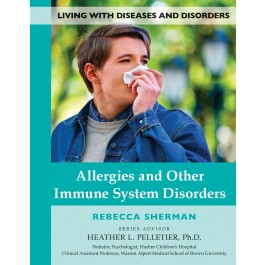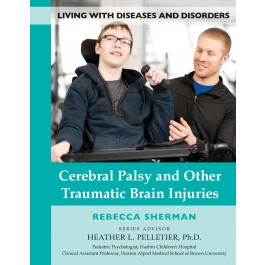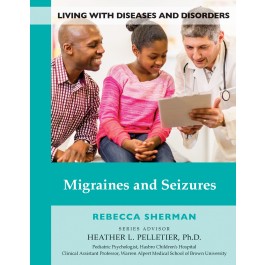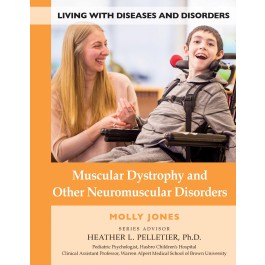LIVING WITH DISEASES AND DISORDERS

6
2018
12+
7th - 12th
7 x 9
by Rebecca Sherman
| Hardcover | ISBN 978-1-4222-3749-6 | $23.95 | Add To Cart |
| eBook | ISBN 978-1-4222-8030-0 | $29.95 | Add To Cart |
The amazingly powerful human immune system works around the clock to keep you healthy. But when something goes wrong, your immune system can actually turn on you and make you sick instead. This book looks at the wide variety of issues that can crop up when the immune system isn’t functioning as it should, including food allergies, eczema, and autoimmune disorders such as lupus. Diseases and disorders transform the experience of childhood, forcing kids to confront adult concerns that we wish they could avoid. The set Living with Diseases and Disorders provides reliable facts about some of the most significant chronic illnesses, while also offering reassuring tips and advice about how to manage the disorders and have the best life possible.
Each title in this series includes color photos throughout, and back matter including: an index and further reading lists for books and internet resources. Key Icons appear throughout the books in this series in an effort to encourage library
readers to build knowledge, gain awareness, explore possibilities and expand their viewpoints through our content rich non-fiction books. Key Icons in this series are as follows: Words to Understand are shown at the front of each chapter with definitions. These words are set in boldfaced type in that chapter, so that readers are able to reference back to the definitions--building their vocabulary and enhancing their reading comprehension. Sidebars are highlighted graphics with content rich material within that allows readers to build knowledge and broaden their perspectives by weaving together additional information to provide realistic and holistic perspectives. Educational Videos are offered in chapters through the use of a QR code, that, when scanned, takes the student to an online video showing a moment in history, a speech, or an instructional video. This gives the readers additional content to supplement the text. Text-Dependent Questions are placed at the end of each chapter. They challenge the reader’s comprehension of the chapter they have just read, while sending the reader back to the text for more careful attention to the evidence presented there. Research Projects are provided at the end of each chapter as well and provide readers with suggestions for projects that encourage deeper research and analysis. And a Series Glossary of Key Terms is included in the back matter containing terminology used throughout the series. Words found here broaden the reader’s knowledge and understanding of terms used in this field.
by Carole Hawkins
| Hardcover | ISBN 978-1-4222-3750-2 | $23.95 | Add To Cart |
| eBook | ISBN 978-1-4222-8031-7 | $29.95 | Add To Cart |
The human respiratory system is vital to life, but it is also vulnerable to damage. About 1 in 14 Americans have asthma, while a thousand new cases of cystic fibrosis are diagnosed every year. The disease called tuberculosis is no longer a major problem in the United States, but it is still a major killer around the globe. Meanwhile, pertussis (whooping cough) seems to be making a comeback. This book provides important information about the causes and treatments of respiratory disorders. Diseases and disorders transform the experience of childhood, forcing kids to confront adult concerns that we wish they could avoid. The set Living with Diseases and Disorders provides reliable facts about some of the most significant chronic illnesses, while also offering reassuring tips and advice about how to manage the disorders and have the best life possible.
Each title in this series includes color photos throughout, and back matter including: an index and further reading lists for books and
internet resources. Key Icons appear throughout the books in this series in an effort to encourage library readers to build knowledge, gain awareness, explore possibilities and expand their viewpoints through our content rich non-fiction books. Key Icons in this series are as follows: Words to Understand are shown at the front of each chapter with definitions. These words are set in boldfaced type in that chapter, so that readers are able to reference back to the definitions--building their vocabulary and enhancing their reading comprehension. Sidebars are highlighted graphics with content rich material within that allows readers to build knowledge and broaden their perspectives by weaving together additional information to provide realistic and holistic perspectives. Educational Videos are offered in chapters through the use of a QR code, that, when scanned, takes the student to an online video showing a moment in history, a speech, or an instructional video. This gives the readers additional content to supplement the text. Text-Dependent Questions are placed at the end of each chapter. They challenge the reader’s comprehension of the chapter they have just read, while sending the reader back to the text for more careful attention to the evidence presented there. Research Projects are provided at the end of each chapter as well and provide readers with suggestions for projects that encourage deeper research and analysis. And a Series Glossary of Key Terms is included in the back matter containing terminology used throughout the series. Words found here broaden the reader’s knowledge and understanding of terms used in this field.
by H.W. Poole
| Hardcover | ISBN 978-1-4222-3752-6 | $23.95 | Add To Cart |
| eBook | ISBN 978-1-4222-8033-1 | $29.95 | Add To Cart |
Although we each only get one birthday a year, on a cellular level we are being reborn all the time. But sometimes cell mutations can occur. These mutations can be harmless, or they can lead to a number of very serious illnesses. Cancer can begin in virtually any part of the body, while sickle cell disease is a particular blood disorder involving the growth of red blood cells. This book explains how these diseases occur and how they can be treated, and it also provides supportive advice for kids who have to deal with these conditions. Diseases and disorders transform the experience of childhood, forcing kids to confront adult concerns that we wish they could avoid. The set Living with Diseases and Disorders provides reliable facts about some of the most significant chronic illnesses, while also offering reassuring tips and advice about how to manage the disorders and have the best life possible.
Each title in this series includes color photos throughout, and back matter including: an
index and further reading lists for books and internet resources. Key Icons appear throughout the books in this series in an effort to encourage library readers to build knowledge, gain awareness, explore possibilities and expand their viewpoints through our content rich non-fiction books. Key Icons in this series are as follows: Words to Understand are shown at the front of each chapter with definitions. These words are set in boldfaced type in that chapter, so that readers are able to reference back to the definitions--building their vocabulary and enhancing their reading comprehension. Sidebars are highlighted graphics with content rich material within that allows readers to build knowledge and broaden their perspectives by weaving together additional information to provide realistic and holistic perspectives. Educational Videos are offered in chapters through the use of a QR code, that, when scanned, takes the student to an online video showing a moment in history, a speech, or an instructional video. This gives the readers additional content to supplement the text. Text-Dependent Questions are placed at the end of each chapter. They challenge the reader’s comprehension of the chapter they have just read, while sending the reader back to the text for more careful attention to the evidence presented there. Research Projects are provided at the end of each chapter as well and provide readers with suggestions for projects that encourage deeper research and analysis. And a Series Glossary of Key Terms is included in the back matter containing terminology used throughout the series. Words found here broaden the reader’s knowledge and understanding of terms used in this field.
by Rebecca Sherman
| Hardcover | ISBN 978-1-4222-3753-3 | $23.95 | Add To Cart |
| eBook | ISBN 978-1-4222-8034-8 | $29.95 | Add To Cart |
The brain is our most vital organ, but it’s also our most vulnerable. It controls everything we think and every action we take, and yet the brain’s ability to heal itself when injured is limited. Brain injuries can occur before or during birth—as is the case with cerebral palsy—or they can be caused by falls, sports, and even warfare. This book explores different types of brain injuries, discusses how they can be prevented or treated, and looks at how to get the most out of life following a brain injury. Diseases and disorders transform the experience of childhood, forcing kids to confront adult concerns that we wish they could avoid. The set Living with Diseases and Disorders provides reliable facts about some of the most significant chronic illnesses, while also offering reassuring tips and advice about how to manage the disorders and have the best life possible.
Each title in this series includes color photos throughout, and back matter including: an index and further
reading lists for books and internet resources. Key Icons appear throughout the books in this series in an effort to encourage library readers to build knowledge, gain awareness, explore possibilities and expand their viewpoints through our content rich non-fiction books. Key Icons in this series are as follows: Words to Understand are shown at the front of each chapter with definitions. These words are set in boldfaced type in that chapter, so that readers are able to reference back to the definitions--building their vocabulary and enhancing their reading comprehension. Sidebars are highlighted graphics with content rich material within that allows readers to build knowledge and broaden their perspectives by weaving together additional information to provide realistic and holistic perspectives. Educational Videos are offered in chapters through the use of a QR code, that, when scanned, takes the student to an online video showing a moment in history, a speech, or an instructional video. This gives the readers additional content to supplement the text. Text-Dependent Questions are placed at the end of each chapter. They challenge the reader’s comprehension of the chapter they have just read, while sending the reader back to the text for more careful attention to the evidence presented there. Research Projects are provided at the end of each chapter as well and provide readers with suggestions for projects that encourage deeper research and analysis. And a Series Glossary of Key Terms is included in the back matter containing terminology used throughout the series. Words found here broaden the reader’s knowledge and understanding of terms used in this field.
by Rebecca Sherman
| Hardcover | ISBN 978-1-4222-3757-1 | $23.95 | Add To Cart |
| eBook | ISBN 978-1-4222-8038-6 | $29.95 | Add To Cart |
Migraines and seizures are neurological disorders, meaning they affect the brain and the nervous system. Seizures are sometimes described as electrical storms in the brain. They are associated with a condition called epilepsy, but there are other reasons people have seizures, too. Migraines, on the other hand, are an especially intense type of headache that can bring on dizziness, nausea, and light sensitivity. This book explores epilepsy, seizures, migraines, and other headaches, explaining how they occur and offering suggestions of how to handle them. Diseases and disorders transform the experience of childhood, forcing kids to confront adult concerns that we wish they could avoid. The set Living with Diseases and Disorders provides reliable facts about some of the most significant chronic illnesses, while also offering reassuring tips and advice about how to manage the disorders and have the best life possible. Each title in this series includes color photos throughout, and back
matter including: an index and further reading lists for books and internet resources. Key Icons appear throughout the books in this series in an effort to encourage library readers to build knowledge, gain awareness, explore possibilities and expand their viewpoints through our content rich non-fiction books. Key Icons in this series are as follows: Words to Understand are shown at the front of each chapter with definitions. These words are set in boldfaced type in that chapter, so that readers are able to reference back to the definitions--building their vocabulary and enhancing their reading comprehension. Sidebars are highlighted graphics with content rich material within that allows readers to build knowledge and broaden their perspectives by weaving together additional information to provide realistic and holistic perspectives. Educational Videos are offered in chapters through the use of a QR code, that, when scanned, takes the student to an online video showing a moment in history, a speech, or an instructional video. This gives the readers additional content to supplement the text. Text-Dependent Questions are placed at the end of each chapter. They challenge the reader’s comprehension of the chapter they have just read, while sending the reader back to the text for more careful attention to the evidence presented there. Research Projects are provided at the end of each chapter as well and provide readers with suggestions for projects that encourage deeper research and analysis. And a Series Glossary of Key Terms is included in the back matter containing terminology used throughout the series. Words found here broaden the reader’s knowledge and understanding of terms used in this field.
by Molly Jones
| Hardcover | ISBN 978-1-4222-3758-8 | $23.95 | Add To Cart |
| eBook | ISBN 978-1-4222-8039-3 | $29.95 | Add To Cart |
Every physical action you take—whether you want to walk or run, type on your phone, or raise your hand in class—depends on clear lines of communication between your brain and your muscles. If that communication breaks down, a condition known as a neuromuscular disorder may be to blame. This book explains the many different kinds of neuromuscular disorders that may occur, including many types of muscular dystrophy, ALS, and Parkinson’s disease. Diseases and disorders transform the experience of childhood, forcing kids to confront adult concerns that we wish they could avoid. The set Living with Diseases and Disorders provides reliable facts about some of the most significant chronic illnesses, while also offering reassuring tips and advice about how to manage the disorders and have the best life possible. Each title in this series includes color photos throughout, and back matter including: an index and further reading lists for books and internet resources. Key Icons appear
throughout the books in this series in an effort to encourage library readers to build knowledge, gain awareness, explore possibilities and expand their viewpoints through our content rich non-fiction books. Key Icons in this series are as follows: Words to Understand are shown at the front of each chapter with definitions. These words are set in boldfaced type in that chapter, so that readers are able to reference back to the definitions--building their vocabulary and enhancing their reading comprehension. Sidebars are highlighted graphics with content rich material within that allows readers to build knowledge and broaden their perspectives by weaving together additional information to provide realistic and holistic perspectives. Educational Videos are offered in chapters through the use of a QR code, that, when scanned, takes the student to an online video showing a moment in history, a speech, or an instructional video. This gives the readers additional content to supplement the text. Text-Dependent Questions are placed at the end of each chapter. They challenge the reader’s comprehension of the chapter they have just read, while sending the reader back to the text for more careful attention to the evidence presented there. Research Projects are provided at the end of each chapter as well and provide readers with suggestions for projects that encourage deeper research and analysis. And a Series Glossary of Key Terms is included in the back matter containing terminology used throughout the series. Words found here broaden the reader’s knowledge and understanding of terms used in this field.
























